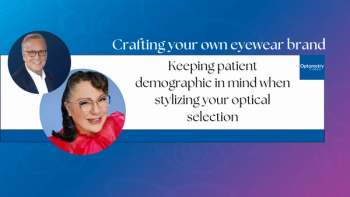
What you missed at AOA 2015
During a session at Optometry’s Meeting 2015 that discussed the future of optometry and eye care, ClearVision Optical President David Friedfeld told attendees how 3D printing technology will change the optical industry.
How 3D printing will affect the optical industry
Seattle-During a session at Optometry’s Meeting 2015 that discussed the future of optometry and eye care, ClearVision Optical President David Friedfeld told attendees how 3D printing technology will change the optical industry.
“Why do I think 3D printing is going to impact the practice?” he asks. “Because it’s an incredible technology, and it’s going to get better and better and better.”
With 3D printing, frames can be designed and manufactured in a day, compared to the months-long process for traditional frame manufacturing. Frames can be custom made in your practice in the material, color, style, and size that best suits a patient.
“Your staff’s role will change. They will be part fashion designer, part scientist, part optician,” Friedfeld says.
3D printing won’t be just impacting the optical side of the eyecare industry.
Adlens to embed electronics into its eyewear
Seattle-During Optometry’s Meeting 2015, Adlens announced its key design project for the next two years that will integrate electronics into its lenses.
Adlens has already defined an electronic architecture, adding the potential for new user interfaces, activity sensors, assisted focus or autofocus and heads-up display (HUD).
“The initial design phase is almost complete-we’ve achieved slimmer frames, lighter components and identified an electronic approach that significantly advances the style and function of the glasses, enhancing user convenience,” says Rob Stevens, DPhil, chief technology officer at Adlens. “Our body of work now is to achieve manufacturing efficiency for our second generation that matches the scalability achieved with the first generation, which we are well on the way to delivering.”
More technology:
These advanced features open up AdlensFocuss, which launched in June 2015, to a multitude of possibilities. Eye-tracking sensors combined with monitoring of lens adjustment will provide health information, accessibility improvements, and enhance a HUD capacity. Adlens will also explore moving to an auto-electronic adjustable focus system that will adapt the corrective power as the eye looks at different objects.
“Our ethos is firmly on improving day to day life and vision for everyone involved, while maintaining the need for fashion and personal style,” says Dr. Stevens. “Our devices will not tread near privacy invasion or tracking. We hope to partner with others in wearable technology to add precision vision to the list of benefits of eyewear with embedded electronics and computing.”
More technology:
Adlens strongly believe it is important their strategy will produce eyewear straddling both optical and consumer tech markets.
“Consumers are living in a golden age of user-focused technology: wearables, live-streaming, mobile ordering platforms, Internet of Things and limitless encyclopedic knowledge available 24/7 through their phones,” says Graeme Mackenzie, DPhil, BOptom, research optometrist and director of industry and regulatory affairs at Adlens. “Sadly, the eyewear industry has not been fully able to embrace the technology trends that are shaping the way we go about our daily lives. Meeting the expectations of the next generation of eyewear user is going to require innovation that is as profound as the incredible imagination of its users. Adlens sees a path to bring about the convergence of multiple markets and technologies and incorporate technology in its eyewear that will make a real difference to the lives of our customers.”
CooperVision Advantage debuts at Optometry’s Meeting 2015
Seattle-During Optometry’s Meeting 2015, CooperVision is unveiled CooperVision Advantage-an inclusive set of business tools designed to support practice growth.
CooperVision estimates that the typical contact lens patient can provide more than $30,000 in lifetime value to a practice. However, an estimated 21 percent of contact lens wearers drop out each year. According to the company, CooperVision Advantage aims to add new patients, minimize the non-clinical reasons for patient loss, and ensure that practitioners have access to the most comprehensive portfolio of contact lenses to provide options for every eye.
Related:
At launch, CooperVision Advantage brings together a number of tools under a single, unified brand. It incorporates EyeCare Prime (which includes WebSystem3), Premier, and LensFerry services-all of which help optimize practice profitability through better patient retention and acquisition, according to the company. CooperVision Advantage also includes the company’s promotional and loyalty programs, training and education initiatives, and other value-added services. Other services will be added over time.
“Being a true partner means more than just providing pricing programs,” says Simon Seshadri, vice president, North America Marketing for CooperVision. “CooperVision Advantage provides key practice-building services to help eyecare practitioners with patient retention, patient acquisition, supply cost, and keeping sales within their practice. It’s one more way we’re focused on growing together, creating a stronger marketplace in which we all can thrive.”
For additional information, visit
Newsletter
Want more insights like this? Subscribe to Optometry Times and get clinical pearls and practice tips delivered straight to your inbox.


















































.png)


